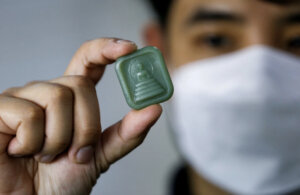Emerald green, also known as Paris green, was incredibly toxic and was at one point used to kill rats in Parisian sewers. (Credit: tdfugere from Pixabay)
Green is the color of nature, the environment and sustainability, but ironically the pigments used to create the color are not all that healthy or environmentally friendly. According to an article on Inhabitat.com many green pigments are actually quite toxic and even with modern dyes and pigments, green is still problematic. Michael Braungart, co-author of Cradle-To-Cradle and famous chemist, says, “The color green can never be green, because of the way it is made. It’s impossible to dye plastic green or to print green ink on paper without contaminating them.” So what are we to do with the chosen mascot color for sustainability and eco-friendliness?
Historically, green has been a difficult color to create – it often faded, degraded, and even burned holes through canvas. In the 18th and 19th century, green wallpapers and paints contained arsenic, which off-gassed toxic fumes and led to many deaths — possibly including Napoleon Bonaparte’s in 1821. Emerald green, also known as Paris green, was incredibly toxic and was at one point used to kill rats in Parisian sewers.
Many of the super toxic green pigments have been banned, but even the modern pigments are still environmentally unsafe. As Alex Rawsthorn of the NYTimes reports, Pigment 7, one of the most common shades of green used in plastic and paper, contains chlorine, which can cause cancer and birth defects. Pigment 36 contains potentially hazardous bromide atoms as well as chlorine, and Pigment Green 50, which is inorganic, contains a “noxious cocktail of cobalt, titanium, nickel and zinc oxide”. So having direct contact with the pigments is unsafe, and on top of that, the pigments make green plastics and paper difficult to recycle or compost, because they contaminate everything else. If what Braungart says is true, then perhaps it’s time to choose new team colors.









